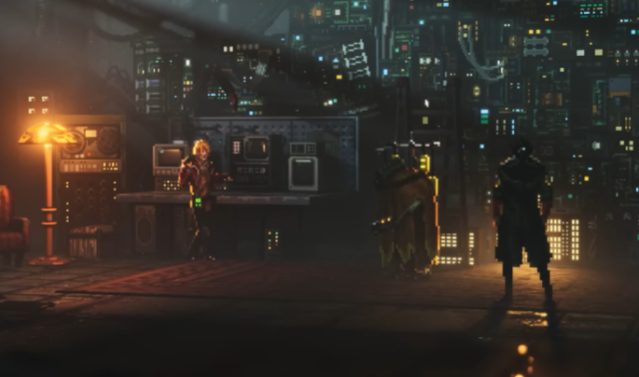The Rise of Cyberpunk in Gaming
The emergence of the cyberpunk genre in gaming can be traced back to the early 1980s when the aesthetic and philosophical notions of dystopian futures began to take root. Initially fueled by literary influences, such as William Gibson’s seminal work, “Neuromancer,” the genre seeped into the realm of video games, offering players a blend of technology and societal decay. Early titles that encapsulated this essence include “Blade Runner” and “Shadowrun,” both of which introduced players to gritty urban environments and complex narratives entwined with themes of artificial intelligence and corporate dominance.
As technology progressed, so did the representation of cyberpunk within gaming. In the 1990s, the advent of 3D graphics allowed creators to develop immersive worlds that reflected the original motifs of the genre. Titles like “Deus Ex” and “System Shock” distinguished themselves not just through their visual flair but also through intricate storytelling that challenged players’ perceptions of freedom and control. The game’s environments, packed with neon lights and towering skyscrapers, allowed players to lose themselves in a reimagined urban landscape, highlighting the conversation around technological advancement and its impact on human identity.
Continuing into the early 21st century, the genre exploded into mainstream gaming, most notably with “Cyberpunk 2077,” which, despite its controversial launch, underscored the continuing relevance of cyberpunk themes in contemporary narratives. Its expansive world design and character-driven storytelling exemplified an evolution within the genre that merged nostalgic elements with modern gameplay mechanics. This resurgence is not merely a revival but a reinterpretation of cyberpunk aesthetics that incorporates retrofuturism, demonstrating how past influences can inform and enrich current game development. The interplay of visual style, narrative depth, and societal critique remains pivotal as the genre evolves, ensuring that cyberpunk continues to be a vital force in gaming culture.
Understanding Retro-futurism and Its Aesthetic
Retrofuturism is a creative movement that blends elements of the past with envisioned futures, capturing an aesthetic that reflects both nostalgia and optimism regarding technological progress. The term itself evokes a sense of longing for a time that never was, where the future is imagined through the lens of bygone eras. This intersection creates a unique visual language that is increasingly significant in various fields, including art, literature, and design. Within the realm of video games, retrofuturism manifests as a distinctive visual style that draws from multiple influences, establishing a compelling and engaging environment for players.
Central to its aesthetic are vibrant color palettes, often characterized by bold neons and muted pastels, reminiscent of 1980s and 1990s design sensibilities. These colors shape the emotional landscape within retrofuturistic environments, inviting players to explore worlds that feel familiar yet alien. Architectural elements of retrofuturism often incorporate organic curves and geometrical shapes, presenting a juxtaposition that enhances the immersive experience. Buildings in these environments may draw inspiration from the streamlined designs of mid-century modernism combined with imaginative interpretations of futuristic technology. This leads to settings that feel both nostalgic and innovative.
Character design in retrofuturism embraces playful originality, suggesting that technological advancements could coalesce with eccentricity. Characters are often depicted with oversized elements or distinctive styles that reflect the predictably optimistic perceptions of the future, evoking a sense of whimsy and adventure. The juxtaposition becomes increasingly clear when comparing retrofuturistic visuals to traditional cyberpunk aesthetics, which often embody darker, dystopian undertones highlighted by neon lighting and urban decay. Whereas cyberpunk emphasizes the societal consequences of technology, retrofuturism combines hope with nostalgia, allowing these genres to coexist while offering contrasting visual experiences. Examples across media, from films like “Back to the Future” to games such as “Katana Zero,” exemplify how retrofuturism enriches the narratives of various platforms while captivating audiences with its unique charm.
Gameplay Mechanics: Merging Old and New
The reimagined visual cyberpunk platformers introduce a unique blend of gameplay mechanics, skillfully merging the nostalgic elements of classic platforming with innovative modern features. At the forefront of this evolution are traditional platforming dynamics such as precise jumping, environmental navigation, and enemy encounters, which remain integral to the gameplay experience. However, these core mechanics are enhanced through the creative implementation of retro aesthetics, providing both a sense of familiarity and a fresh perspective for players.
One of the most notable aspects is the use of pixel art graphics, which draws inspiration from the 8-bit and 16-bit eras of video gaming. This choice fosters an engaging visual style that resonates with retro enthusiasts while attracting a new generation of gamers. The simplicity and charm of pixel art not only evoke nostalgia but also serve to effectively convey the vibrant and dystopian themes typical of the cyberpunk genre.
Furthermore, the aural experience is significantly enriched by the incorporation of chiptune soundtracks. These soundscapes enhance gameplay by immersing players in a vibrant auditory environment, reminiscent of classic console games, while simultaneously utilizing modern composition techniques to create unique auditory experiences. The combination of nostalgic and contemporary sounds supports the overall retrofuturistic atmosphere, allowing players to connect with their gaming heritage while enjoying modern innovations.
Level design prominently reflects homage to classic gaming with intricately crafted environments that encourage exploration and experimentation. Each stage is meticulously designed to balance challenge and fun, including hidden areas and collectibles that hark back to the gameplay of yore. This fusion of old and new mechanics promotes not only a rewarding challenge but also a journey through a thoughtfully constructed world, steeped in the rich visual cyberpunk narrative.
Cultural Impact and Community Response
The resurgence of reimagined visual cyberpunk platformers has significantly impacted the gaming community, igniting a strong response from both players and developers. These games merge elements of cyberpunk aesthetics with retrofuturism, creating unique experiences that resonate with a diverse audience. As players engage with these titles, they often explore themes of dystopian futures and technological advancements, which leads to a deeper cultural dialogue within the community.
One notable aspect of this cultural impact is the wave of creativity sparked by these games. Fans frequently express their appreciation through various artistic mediums, including fan art, music remixes, and even cosplay. This creative outpouring signifies a robust community investment in the aesthetic and thematic elements presented in these platformers. When players share their interpretations online, they contribute to a collective understanding of the genre, highlighting how nostalgia and innovative gameplay interweave to form a captivating gaming experience.
Furthermore, community engagement has been enhanced through forums and social media platforms, where discussions flourish around gameplay mechanics, narrative depth, and artistic style. Players often share insights on how these reimagined platformers draw from the rich history of cyberpunk while incorporating modern gaming trends. This dialogue not only enriches player experiences but also presents developers with valuable feedback, fostering a dynamic relationship between creators and their audience.
Critically, these visual cyberpunk platformers have received acclaim for their ability to balance homage to classic titles while introducing innovative gameplay features. The community’s response reflects this appreciation, as players champion the combination of nostalgia and modernity, affirming the importance of such titles in the gaming landscape. In this evolving conversation, the cultural impact of these games continues to affirm their relevance, driving further exploration of the cyberpunk genre.


No responses yet